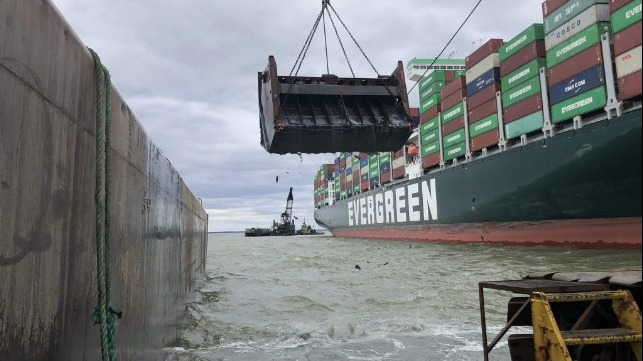Salvors Begin Dredging Operation to Free Ever Forward From the Mud

The first phase of the operation to free the grounded containership Ever Forward has gotten underway with two large dredges being positioned at the front and back of the vessel on Sunday, March 20. No timeline was released or estimates on how much material they expect to remove from around the vessel before they will attempt to pull the Ever Forward free of the mud and back into the shipping channel.
The salvage operation is being run by Donjon Marine Smit, which was appointed by Evergreen. The operation is being overseen by a joint command established by the U.S. Coast Guard along with various agencies including the Maryland Department of the Environment and Maryland Port Administration.
Donjon has brought in two clamshell dredges to undertake this phase of the effort. One of the dredges, the Dale Pyatt, is reported to be the largest clamshell dredge in the western hemisphere. Owned by Cashman Dredging the vessel is 1,179 gross tons with a length of 180 feet. The company reports that it has an environmental bucket able of handling 60 cubic yards or a heavy duty bucket capability of up to 28 cubic yards of material. Its maximum dredge depth of 100 feet. The Dale Pyatt has been positioned near the stern of the containership and alongside they have also placed a barge that will collect the material being pulled from around the ship.
Near the front of the containership, Donjon positioned one of its clamshell dredges, the Oyster Bay. Built in 2018, the second dredge is slightly smaller with a capacity of 15 cubic yards of material in its bucket or a heavy duty capability of 8 cubic yards. It has a maximum digging depth of 55 feet and they have also placed a barge alongside to collect the material. William Doyle, Executive Director of the Port of Baltimore reports one positive outcome is that the material dredged from around the containership will be reused in their ongoing operation rebuilding islands in the Chesapeake Bay. “All dredge material excavated will be re-used for the beneficial use of rebuilding Poplar Island,” Doyle wrote in a Tweet.
Evergreen reported that the salvage plan calls for removing mud from around the 1,096-foot vessel. The goal is to increase the buoyancy of the hull and increase the clearance between the propeller, rudder, and the seabed. The dredges are not able to dig under the vessel but they can clear around the hull and possibly most critically the path they plan to use to pull the containership so that the propeller is free and not pulled through the mud and damaged.
Video on YouTube shows the dredging underway with traffic continuing on the Chesapeake (Baltimore Shipspotting/YouTube)
“After sufficient mud is excavated, the amount of ballast water on Ever Forward will be adjusted to reduce the ship’s weight and the refloating operation will begin using both the tugboats and the power of her main engine,” Evergreen said in its statement about the salvage plan. The company, also said they would seek to time the refloating effort to the most beneficial tides, but experts point out that under normal conditions there is not a large tidal swing in the Chesapeake Bay.
Donjon has also put out a call for available tugboats to join in the effort to pull the vessel free. The hope is that they will be able to free the Ever Forward without offloading containers, which would be a complicated and slow process.
Since the grounding more than a week ago, the U.S. Coast Guard has been monitoring the vessel and reported that they had ordered the crew to conduct soundings of the vessel’s tanks and monitor for any possible signs of discharge. No pollution has been reported.
